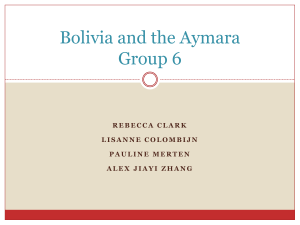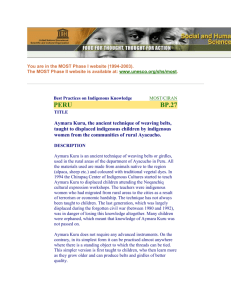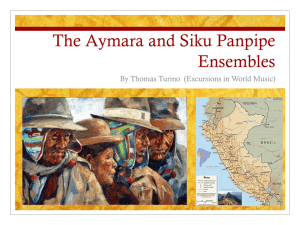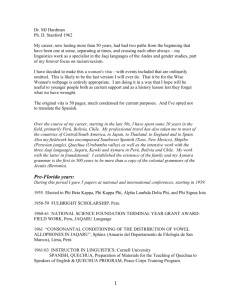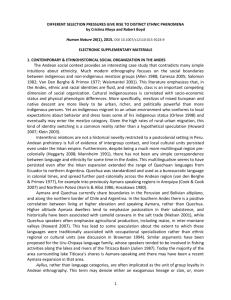Aymara by www.boliviabella.com
advertisement
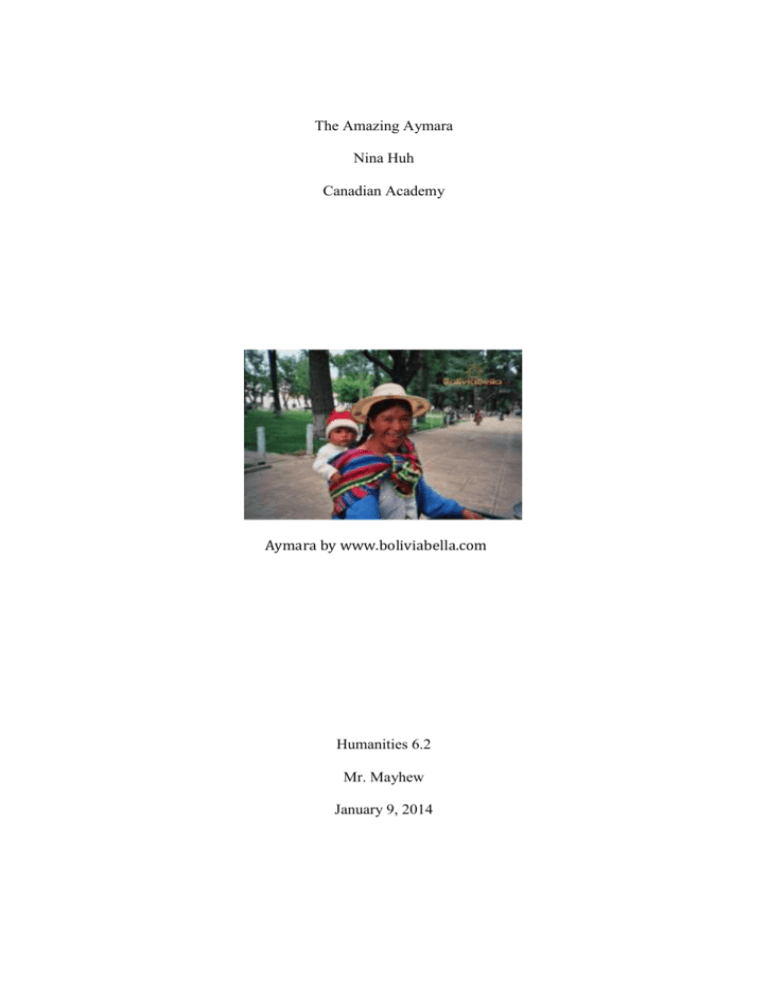
The Amazing Aymara Nina Huh Canadian Academy Aymara by www.boliviabella.com Humanities 6.2 Mr. Mayhew January 9, 2014 The Amazing Aymara Introduction Most people don’t freeze-dry potatoes. It’s pretty much common sense. But for the Aymara people, it’s just one of many things that they do. The Aymara are an indigenous tribe located mostly in Bolivia but also in parts of Peru and Chile. Although the Aymara are ancient, they aren’t fading away anytime soon. Modern life has been introduced, as well as education, and there are still a good 2.5 million people in the tribe. Judging by how things are going it looks like the Aymara are here to stay for quite a long time. Location The Aymara are scattered around three places: 2,000,000 in Bolivia, 500,000 in Peru, and 20,000 in Chile. Many live in Bolivia on the altiplano, the very high mountains. The altiplano is 10,000 to 20,000 feet above the sea, and therefore this makes the weather freezing cold. The main language for the Aymara is still Jaqiaru, although these days there are many bilingual people who speak both Spanish and Aymara. There are even some trilingual people, and they speak all Spanish, Aymara, and Quechua. Although the high altitude has made life and growing crops more difficult, the Aymara have survived well as there are still 2.5 million of them. Map by infoplease.com Black dots represent population. Religion and Rites of Passage The Aymara believe in the mountain, sky, and nature gods. One of their most worshipped gods is Pachamama, the earth goddess. The Aymara worship her to grow a good crop. In the colonial period, Catholicism was first introduced to the Aymara and now they have adopted it. They go to mass and do things that every other Catholic would do, but they still have bits of their old beliefs inside them. A child is introduced to the culture and traditions that are normal for an Aymara family. One memorable event is the rutucha, the child’s first haircut. They let hair grow normally until the child is about two years old. When it seems like he or she is healthy and won’t become sick anytime soon, they shave off all of their hair. Clothing Men and women wear different clothing. City men wear normal Western clothing, but the altiplano men wear much warmer clothing as the temperature is very cold. They often wear cotton pants, wool caps, and sometimes they wear ponchos. City women wear polleras, skirts made out of velvet with bowler hats. Altiplano women wear many wool skirts and sweaters. On special occasions, women often wear 5 to 6 skirts layered on top of each other. Colorful shawls and scarves are used to tie babies or different kinds of goods to a mother’s back. Both genders wear sandals and shoes, but go barefoot although it is very cold. Food The Aymara have one food essential, aji. Aji is a hot pepper seasoning that is used in almost all dishes. Potatoes, barley, quinoa and corn are also very important to the Aymara as they eat these all the time. Quinoa is a type of nutritious grain that has been grown in the Andes for hundreds of years. Quinoa is also now a popular health food in the United States as well. Many Aymara in the country eat plenty of potatoes and grains. Because it is so cold on the altiplano, it is possible to actually free-dry foods like potatoes and meat. After one week of laying potatoes outside and pounding them, the result is chuno, hard potato pieces that will last very long. Llama meat, also known as charqui, is freeze-dried as well. Because it is so cold, the weather really limits the kinds of crops that can be grown. Families that live on different altitudes can grow different crops and often trade or sell their harvest. Everybody takes part in growing crops. The men plow and dig but cannot plant. The most important procedure, planting, is saved for women because of the connection with Pachamama. The Aymara eat meat from sheep, llamas, and alpacas. Some eat chickens, cows, and frogs as well. Another thing that they eat is fish. Fish from the famous Lake Titicaca or other smaller lakes and rivers are also very important to the Aymara diet. Family Life The most common type of family is the extended family. A typical Aymara family could consist of parents, unmarried children, and often grandparents. They either live in a few small houses or one huge house. The Aymara have many children so 7 or 8 children are not uncommon. In most indigenous cultures women are not treated equally, but in the Aymara it is different. A woman’s tasks are seen just as important as a man’s tasks. Planting, especially, is a great task that women take care of that is highly appreciated. Women can also smoke, drink, vote, and do anything that men can do. Women have most of the family’s inheritance rights, so that means houses or other property will be passed down from mother to daughter. This shows that not all property is passed down from father to son. Aymara children have many chores, especially girls, who have them at a young age. Tasks can include taking care of younger siblings or a herd. Marriage is a long and tiring process and can take many months. A marriage has things like inheritance feasts, a planting ceremony, and a house building, but also many more. Although marriage is a happy celebration, divorce is still accepted. Art and Music The Aymara love music and have a big musical background from the preInca times. Popular instruments include drums, violins, and wooden flutes. Aymara also like to use panpipes, the pututu horn, and zampoñas. A zampoña is a panpipe. The Aymara also love dance and they like to make it colorful. All dancers wear very bright clothing to attract attention. The bright colors are said to represent Spanish colonizers. One popular comical dance is the “Old Man Dance.” A Spanish man with a top hat bends down and comically acts and mocks an old Spanish man. Social Conditions In the past, the Aymara were not treated as equally as other Bolivians. Bolivians often took their land and resources, looking down on them. In the 1950s the Bolivians and the government finally treated the Aymara a bit nicer but the treatment was not equal. In 1952 the Aymara people were given just a few civil rights that the Bolivians had had the entire time. But with education, the Aymara are now used to a more modern lifestyle than before. Although this is a huge plus, there are still places in poverty with racial issues. Many Aymara move to the city for their own reason but it makes their life harder as it is not as easy to grow and harvest crops in the city. My Inquiry Question: How do the Aymara mix Catholicism and their own traditional beliefs? Catholicism has been introduced to the Aymara but they still hold on to their old beliefs at times. Normally, a Catholic would probably pray to God, but the Aymara pray to and make offerings to Pachamama. They pray to Pachamama to help them grow a good crop, which of course is very important to them as almost all they eat is grown and herded and not bought from a supermarket. Conclusion I think that living for the Aymara has been hard over the years, but they have adjusted well through many hardships- daily life in the city, crop growing difficulties, and not being treated equally at times. But I think and hope that the Aymara will not become extinct and will keep going. With 2.5 million in their tribe, they have a good chance. But indigenous tribes become a little bit closer to extinct every single day. I think that the Aymara have plenty of room to grow. Their unique music tastes might interest new artists. Their different foods, like freeze-dried potatoes, might catch a restaurant’s attention. Things like that make the Aymara so unique. The only problem is just that they need to get noticed more. People need to know what kind of great people that the Aymara really are. Nina H. References Bolivia Facts, People, Culture, News, Food, Maps, Santa Cruz, La Paz, Cochabamba. (2014, January 14). Bolivia Facts, People, Culture, News, Food, Maps, Santa Cruz, La Paz, Cochabamba. Retrieved January 13, 2014, from http://www.boliviabella.com Countries and Their Cultures. (2014, January 10). Aymara. Retrieved January 10, 2014, from http://www.everyculture.com/wc/Afghanistan-to-BosniaHerzegovina/Aymara.html Detailed maps of all countries, administrative and road maps, physical and topographical maps, maps for GPS navigators and other maps of the World.. (2014, January 10). Vidianicom RSS. Retrieved January 7, 2014, from http://www.vidiani.com/ Detailed maps of all countries, administrative and road maps, physical and topographical maps, maps for GPS navigators and other maps of the World.. (2014, January 10). Vidianicom RSS. Retrieved January 7, 2014, from http://www.vidiani.com/ APA formatting by BibMe.org.
